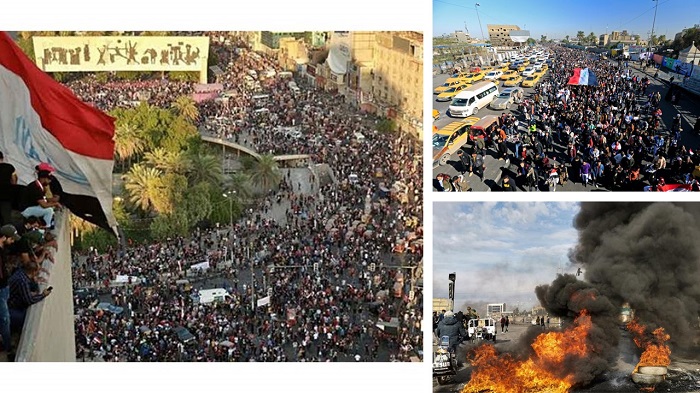
Millions of Iraqis took to streets, demanding a none corrupt government and eviction of the Iranian regime from their country, January 2020
Several hundred, according to some sources, and several thousand, according to other sources, rallied last Friday, January 24 in Baghdad in response to a call for a “million-man strong demonstration against US presence in Iraq” by Moqtada a-Sadr, an Iraqi Shiite firebrand known for his extreme and unforeseeable political positions. In a tweet sent later in the day, Sadr showed his disgust towards the Iraqis who did not take his word for taking part in the rally. From his headquarters back in the city of Qom in central Iran, Moqtada a-Sadr had been preparing the move for several weeks, in a bid to take a leading position in ongoing Iraqi unrest along with Iranian support.
But Iraq seems a lost ground for mullahs since IRGC’s Quds Force commander Qassem Soleimani was killed on January 3 in a US army drone attack close to Baghdad airport.
The country has been witness to growing popular unrest as the population protest government corruption and Iranian intervention in the country. Hundreds of thousands of protesters, mostly the youth and women, gathered in Tahrir square in central Baghdad in October and have stayed there ever since. They are asking for total government, even regime change.
Iraqi PM Adel Abdolmehdi resigned on November 30, staying as caretaker until a government would be assigned to respond to popular demands. In the meantime, militia forces forming what is known in the country as Hashd-a-shaabi (popular mobilization forces) acted as the most efficient repression force against the movement. Not less than 600 protesters have been killed and thousands wounded or abducted by militia mostly under Iranian control.
In the first days of the uprising, Qassem Soliemani took part in an urgent meeting of the Iraqi National Security Council normally chaired by the Prime Minister. Soleimani put forward methods to curb the demonstrations and to quench popular unrest.
His brutal approach to such cases was known to all. During seven years, his Quds force had been implicated in harshly oppressing the Iranian opposition MEK Iran staying in camp Ashraf, then camp Liberty in Iraq and presumably under official protection by the Iraqi government. 146 MEK Iran members were killed before the organization finally relocated to Albania following US and UN intervention.
Despite all efforts by Soleimani, a quick solution to the problem was not found. He then planned the attack on US forces north of Iraq by the militia in the hope of creating an anti-American sentiment in the country able to divert public rage from Iran towards the USA. The military attack, which was answered by harsh US retaliation against the militias’ garrisons killing 50 militia members and commanders brought Soleimani to organize a violent protest against the US Embassy premises in Baghdad’s green zone. Protesters put on fire several points around the compound and part of the perimeter wall was destructed by them. All militia commanders known for their strong affiliation with Tehran were present in the anti-US rally organized around the Embassy compound, and plans were made to organize huge sit-ins in protest, seemingly against the US retaliation in the north, but in reality, aiming to divert people from anti-Iranian regime gatherings in Tahrir square through a wave of anti-American fervor.
Soleimani was entering Baghdad from a visit to Hezbollah’s Hassan Nasrollah in Lebanon and a visit to Syria and was going to oversee the organization of the anti-US rallies around the US Embassy compound.
His disappearing from the Iraqi scene thwarted the scheme to turn the anti-Iran tide against the US and caused immediate havoc in the Iranian regime’s total planning for Iraq.
#MEK Iran: Iranian Regime Moving Further into Isolation https://t.co/qO6kYrXGv2#Soleimani #FreeIran2020#IRGCTerrorists
— MEK Iran (Mujahedin-e Khalq) (@MEK_Iran) January 11, 2020
The immediate effect was the lack of trust created in the Iranian-backed militia forces in Iraq. One of the most influential among them, Abu Mahdi al-Mohandess being slain along with Qassem Soleimani in the US drone attack, other commanders felt unsafe in the country and flocked to Iran on the pretext of participating in Soleimani’s funeral ceremonies. Most of them settled in the holy city of Qom in central Iran, out of presumed US reach.
In the meantime, in a last-ditch effort to stop or slow Iraq’s slipping through his fingers, the Iranian regime tried to continue along with Soleimani’s plan of diverting the anti-Iran rage to anti-US, through organizing Friday’s demonstration initiated by Moqtada a-Sadr.
But with the end result poorer than expected, Sadr was obliged to take distance with the hundreds of thousands of demonstrators gathered in the Iraqi capital for four months and shaking southern Shiite Iraqi cities. He had been playing a not so clear role during the months of unrest, but with Friday’s demonstration, he clearly showed his tendency towards the Iranian regime and changed camp.
https://twitter.com/HeshmatAlavi/status/1221481700536061953
The big question remaining however is whether the mullahs in power in Tehran would ever again be in a position to dictate their will in Iraq, especially after Qassem Soleimani.
